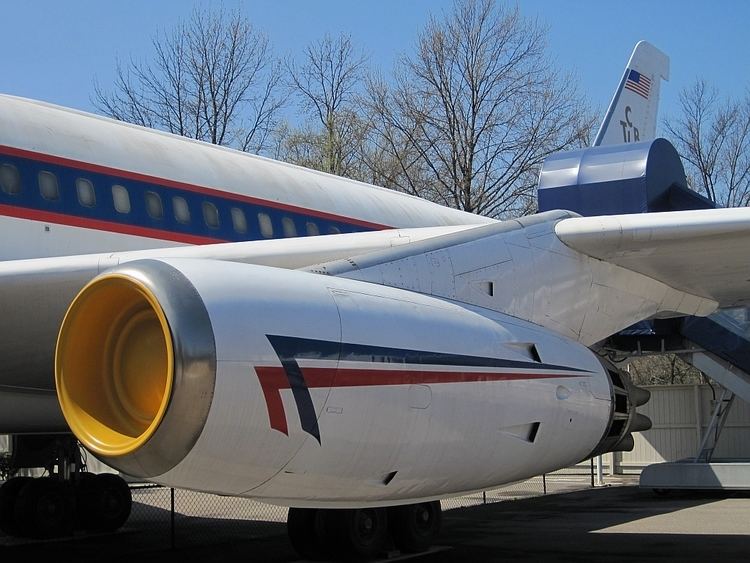 | ||
The General Electric CJ805 is a jet engine which was developed by GE Aviation in the late 1950s. It was a civilian version of the J79 and differed only in detail. It was developed in two versions. The basic CJ805-3 was a turbojet and powered the Convair 880, while CJ805-23 (military designation TF35), a turbofan derivative, powered the Convair 990 airliners.
Contents
CJ805-3
The CJ805-3 engine was General Electric's entry into the commercial engine business. Its application, the Convair 880, followed very soon after the military J79, on which it was based, entered service. An RB-66, with CJ805-3 engines installed, gained experience for airline use by flying simulated airline routes.
The engine was fitted with a thrust reverser and noise-suppressing nozzle. Focus on commercial jet engine noise, and the requirement for noise suppressors, was very real before the Boeing 707 went into service 2 years before the Convair 880. There was already a lawsuit, by residents around Newark airport, concerning the noise from existing propeller-driven aircraft such as the Super Constellation, Stratocruiser and DC-7C.
CJ805-23
Transatlantic service needed a higher thrust version of the existing turbojet and a demonstrator engine with a single-stage front fan attached to the compressor was run. It was difficult to start and operate. This experience led to the aft-fan which didn't compromise the operation of the gas generator.
Although nowhere near as successful as the Pratt & Whitney JT3D, the CJ805-23 was a very advanced engine for its time (late 50's). Like the JT3D, the CJ805-23 was a turbofan derived from a turbojet. General Electric's approach was to take the single spool CJ805-3 turbojet and incorporate an aft fan/turbine system into the exhaust system. Each turbine blade was an integral part of a blucket, the outboard section of which was a fan rotor blade. Running freely on a stub shaft, a series of bluckets, mounted on a disc, made up the aft rotor assembly. The efflux from the turbojet expanded through the (inner) turbine annulus. thus providing power directly to the fan blades located in the outer annulus. A full-length cowl, an annular exhaust system and a bucket thrust-reverser were fitted for the Convair 990. A relatively short fan cowl and thrust reverser was used to demonstrate the engine on the Sud Aviation Caravelle. The CJ805-23, if chosen, would have replaced the Rolls-Royce Avon. Rolls-Royce quickly built and tested an aft-fan demonstrator Avon to compete with the greater thrust and lower sfc of the CJ805-23. In the end the Caravelle was re-engined with the P&W JT8D turbofan.
A similar short cowl arrangement to that demonstrated on the Caravelle had been employed on the Metropolitan-Vickers F.3, during WW2.
The unique feature of the -23 was the transonic single stage fan . NACA had done a lot of research on multistage transonic compressors during the 50's. Using this data, GE decided to design and test a high pressure ratio single stage transonic fan. Much to their amazement the unit more than met the design target, including that of high efficiency. A modified version of this research unit was subsequently incorporated into the CJ805-23 aft fan. With no experience of transonic fan design and little time available, Pratt & Whitney had to resort to using 2 fan stages to produce a similar pressure ratio for their JT-3D turbofan. Although not an overhung design, the -23 transonic fan did not require any inlet guide vanes. There was, however, a series of structural vanes to help support the fan casing .
The CJ805 program was not a commercial success. However, extensive resources were put into improving the durability to make it suitable for airline service. This led to a smaller aft-fan engine, the General Electric CF700, used in the Dassault Falcon 20 business jet.
At the same time the lift fan technology used in the XV-5 Vertifan was being developed into a high thrust cruise fan for the Lockheed C-5 Galaxy.
Variants and applications
Only a single Sud Aviation Caravelle intended as a prototype for the US market, was equipped with the CJ805.
Specifications (CJ805-3B)
Data from FAA Type Certificate Data Sheet, E-306
General characteristics
Components
Performance
Specifications (CJ805-23B)
Data from [1]
